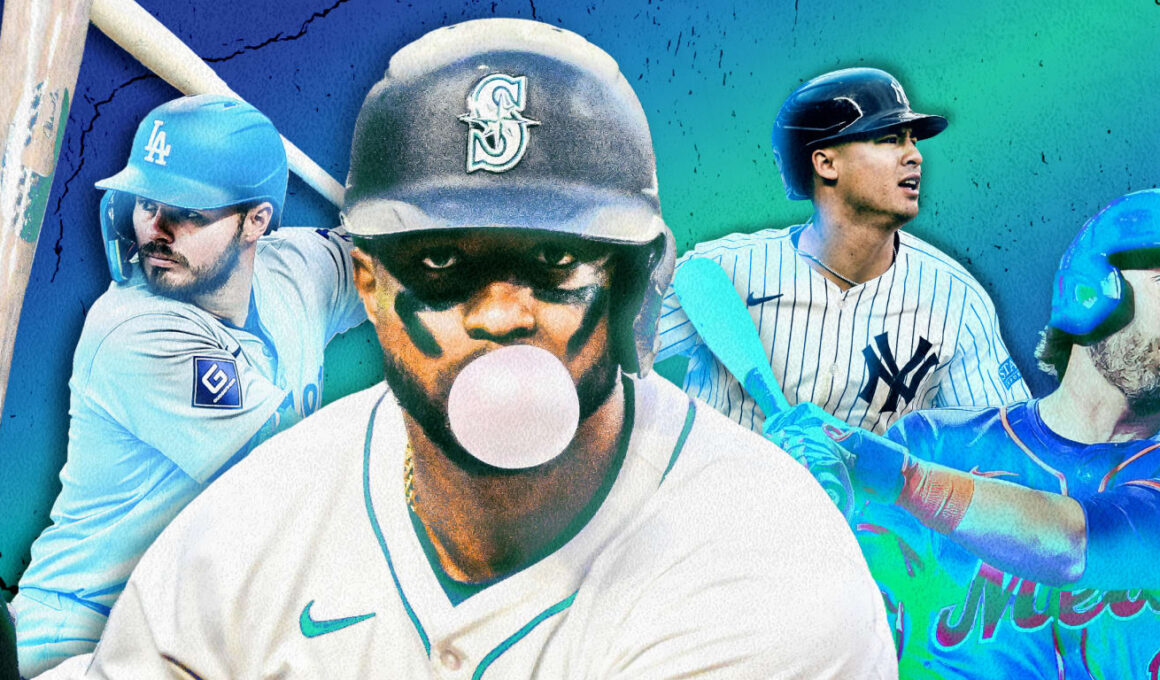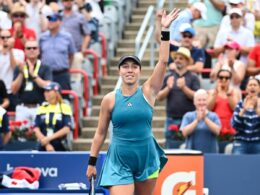Slap hitters, no more: 4 finding power with new approach
When Statcast rolled out the first public bat speed metrics back in May, two things immediately became clear. First, it was satisfying to see how quickly the data became meaningful, because in the same way that you don’t need more than a small handful of fastballs to be confident that Mason Miller throws harder than, say, Kyle Hendricks, you don’t need but a few swings to know who swings fast and who doesn’t.
The second thing is the flip side of the coin: Three months later, not a whole lot has changed. Giancarlo Stanton and Oneil Cruz still swing the fastest bats, just like they did on day one. If you look at only July, it was still … Stanton and Cruz. Matt Olson, to pick a slugger at random, has barely budged at all. It is, again, like fastball velocity: You know it when you see it, and it doesn’t change quickly, at least not in the same way you can gain or lose dozens of points of batting average or ERA thanks to a hot or cold week or two.
But just because it doesn’t change a lot, in-season, doesn’t mean it doesn’t change at all. For a small handful of batters who spent the first half of the season swinging slowly, trying to make contact, and generally not performing well, we’ve seen some real changes. We’ve seen them give up on the “contact at all costs” model to swing faster, pull more, and get the ball off the ground. We’re not just looking for “performing better,” because anyone can get hot over a week; we’re looking for underlying changes too.
These four are not the only ones swinging harder, because Jarren Duran, Nolan Arenado, Nick Castellanos, and others are as well. They’re just a similar flavor of slap hitters who appear to have changed their approach considerably, like Steven Kwan earlier this year.
It’s not excellent bat speed, to be clear. But it’s better – and maybe not from the types of players you’d expect. (While we usually use 75 mph as the line for a “ fast swing,” we’re using 70 mph here, simply because these are slow swingers to begin with. All numbers are through Thursday’s games.)
Gavin Lux, Dodgers
- First-half swings of 70 mph+: 39%
- Second-half swings of 70 mph+: 68%
Lux was a first-round pick back in 2018 and was once considered the No. 2 prospect in baseball (2020, by MLB Pipeline), but to say his journey has been a rocky one since undersells it more than a little. He never hit that much in parts of three MLB seasons across 2019-21 (82 OPS+), then had a just-OK 2022 before missing all of 2023 with a knee injury, then got bounced off of shortstop this spring due to questions about his defense, then spent months putting up a terribly disappointing .213/.267/.295 first half – putting his roster spot into question as the Trade Deadline neared.
Nearly 1,300 plate appearances into his career, entering the All-Star break, Lux was a mere .683 OPS hitter. It wasn’t happening, and it was fair to ask if it would ever be happening. It’s still fair to ask, because while the .429/.500/.829 line he’s put up since the break is fantastic, it does come with some wild batted ball luck metrics that won’t last. (He will not continue to slug .829, we regret to state.) It’s not just bat speed, either:
- First-half pull rate: 37%
- Second-half pull rate: 54%
- First-half ground ball rate: 54%
- Second-half ground ball rate: 46%
Good fortune aside, all those changes show you there’s likely some there there, too, and that’s exactly what you’re looking for in smaller samples – is this just a fluke, or can you point to something happening?
“Just trying to be a little bit more aggressive,” Lux told MLB.com’s Juan Toribio on July 24 about what had changed. “Overall, just trying to be aggressive with my swing, my load and try not to be safe. I think that’s the big takeaway I’ve had.”
Try not to be safe, which is how you up your strikeout rate from 20% in the first half to 29% in the second half – and be a wildly more valuable hitter for it.
Anthony Volpe, Yankees
- First-half swings of 70 mph+: 39%
- Second-half swings of 70 mph+: 54%
We’ve seen a few different versions of Volpe so far in his short career. As a rookie, a 20/20 campaign seemed superficially strong, but a poor .209/.283/.383 line produced a mere 81 OPS+, making him nearly 20% worse than league average as a hitter. Entering 2024, Volpe’s approach was broadcast loud and clear: He was planning to change his swing path to focus more on all-field line drives in an attempt to cut down his strikeouts – even if it came at the expense of homers.
For a very brief moment, it seemed like a success. Volpe hit .382/.477/.564 over the first 15 games of the season, striking out just nine times – albeit with a wildly unsustainable BABIP, indicating a great deal of good fortune. He then spent the remainder of the first half being one of the weakest hitters in the game, crash-landing with a .194/.222/.277 line from the start of June through the All-Star break. He did, to his credit, cut down on strikeouts, from 28% last year to 21% in the first half. He was just replacing them with weak groundouts, at the cost of what power he’d shown in 2023.
At one point, he went more than two full months without a home run, and 17 games without a walk. Even now, he has the largest drop in pull rate since last year and the second-largest increase in ground ball rate. But since the second half began, Volpe has hit .333/.346/.569. As you can see, he’s clearly swinging harder, which is somewhat correlated to the fact that his pull rate is up from 29% in the first half to 39% in the second – your bat speed at contact is faster when it comes to the pull side – but consider this, too:
- In 2023, Volpe hit 11 homers on pulled fly balls
- In 2024, Volpe has 13 total pulled fly balls.
Volpe actually went more than a month without a single pulled fly ball, then finally did it twice after the break, hitting homers off Zack Littell and Gregory Soto. Whether this is yet another “new” Volpe remains to be seen, but what’s clear is that despite how excited much of the fanbase got over the flat swing and more contact … it simply wasn’t working. This might be better.
Jeff McNeil, Mets
- Through July 4, swings of 70 mph+: 33%
- Since July 5, swings of 70 mph+: 41%
McNeil, for much of the season, seemed like he might be on the Avisaíl García / José Abreu path of underperforming hitters with big contracts being cut loose with time and money still remaining, because it just completely was not working. In 2022, McNeil was a star, hitting .321 with a 140 OPS+, but as expected, he was hurt by the shift restrictions (among other issues), finding his OPS dropping from .836 to .711 last year, then a miserable .584 through the end of June. He was in the conversation for “ weakest hitter in baseball,” and he’d begun to lose second base time to journeyman José Iglesias – even being benched for nearly a week in early June.
All seemed lost, and then on July 5 the most improbable event happened: The light-hitting McNeil, mired in a monumental slump, hit a homer off of Paul Skenes, of all people. He was a little better after that, and then hit two homers on July 19, and went deep on back-to-back days on the 22nd and 23rd, and all of a sudden, McNeil has hit .310/.346/.634 since that day in Pittsburgh.
We chose that day as our dividing line in part because it was Skenes, but mostly because that’s exactly when McNeil said started doing something different. Later, he added more detail to the plan.
“In ’22 when they were shifting on me, I just kind of [had to] go the other way,” McNeil told MLB.com. “I was just trying to hit line drives, just trying to keep the ball out of the air, trying to hit line drives. And I feel like your swing kind of gets a little bit messed up once you’re trying to like, guide the ball. If you’re trying to guide the ball out there, it’s tough. So lately I’ve been trying to hit the ball wherever it’s pitched and hit it hard.”
- Through July 4, pull rate: 33%
- Since July 5, pull rate: 56%
It’s not, clearly, that McNeil – or Lux, or Volpe – needs to become an all-or-nothing monster masher like Stanton. But it’s clear that an approach based on hunting singles without any power is incredibly difficult to maintain, unless you’re a generational contact bat like Luis Arraez.
Victor Robles, Mariners
- w/ Nationals, swings of 70 mph+: 30%
- w/ Mariners, swings of 70 mph+: 44%
This one is a little different, because it comes with a team change and a strikeout decline. Like Lux, Robles was once a top-five prospect, and he was the starting center fielder on the 2019 champion Nationals team, pairing what was at the time elite-level defense with a good-enough bat. But due to injuries, the speed and defense declined to just-OK, and the bat all but collapsed with a .225/.302/.313 line across 2020-23, and at the end of May, the Nationals cut him loose, bidding farewell to the last remaining position player from the World Series club.
He quickly signed with Seattle, first as an extra hand, then as the primary center fielder after Julio Rodríguez got injured. It’s only been 85 plate appearances, yet it’s hard to look past a .360/.422/.520 line from someone who had been one of the weakest hitters in the game for a half-decade.
“He’s the kind of jolt, energy we need,” Mariners catcher Cal Raleigh told MLB.com, though it appears that unlike some of our other hitters here, the bat speed jump was less the primary goal and more a secondary effect of improved mechanics.
“I’ve always been a quick hips type of guy,” Robles said via interpreter. “And [Seattle dir. of hitting strategy Jarret DeHart] made some type of balance in between and helped me with a scissor swing a little bit, so I can have more direction to the ball. I just got close to him and told him that I’m here to do whatever I thought was going to help me out.”
The bat speed jump is noticeable, but what’s more important is what it’s led to, like this …
- w/ Nationals, hard-hit rate: 17%
- w/ Mariners, hard-hit rate: 36%
… and this:
- w/ Nationals, strikeout rate: 27%
- w/ Mariners, strikeout rate: 16%
Despite the fact that Robles is in the eighth season of his career, he only just turned 27 in May, meaning that if there’s anything real to this change, there’s still time for him to realize it. When he took Philadelphia’s Tyler Phillips deep on Friday night, it left the bat at 109.8 MPH — the third-hardest hit of his entire career, and hardest in more than five years.








